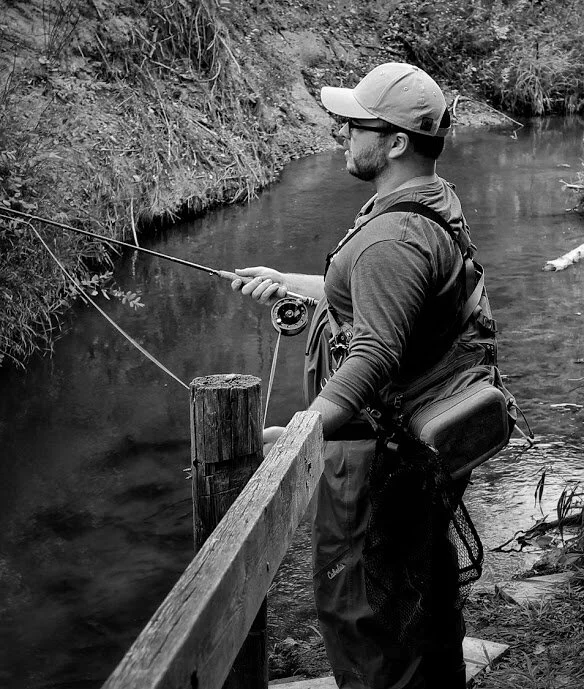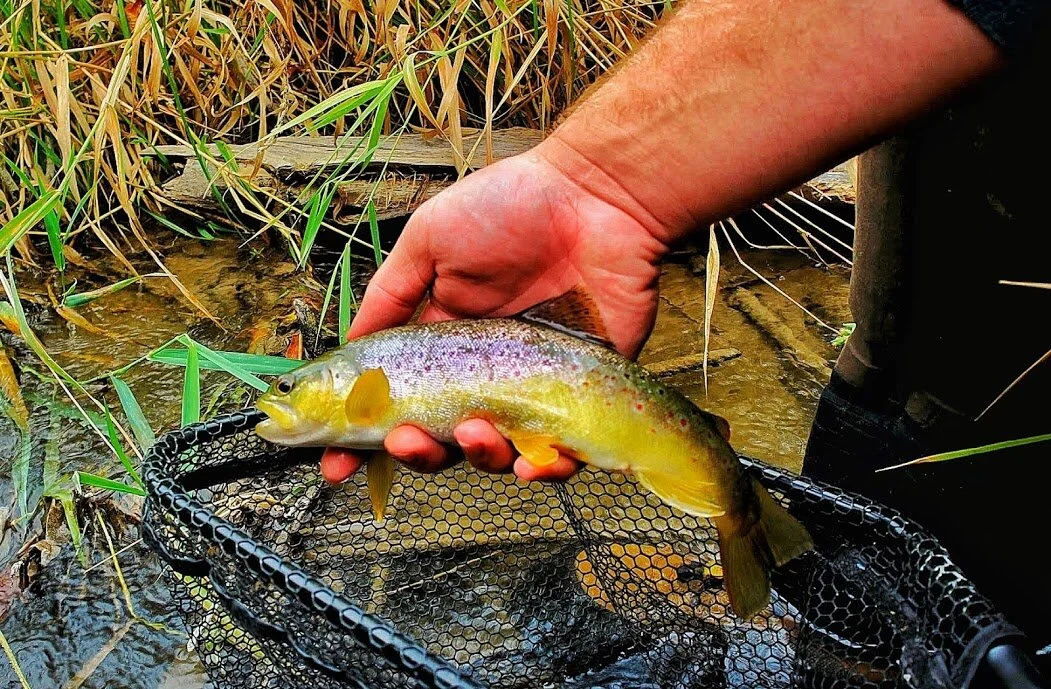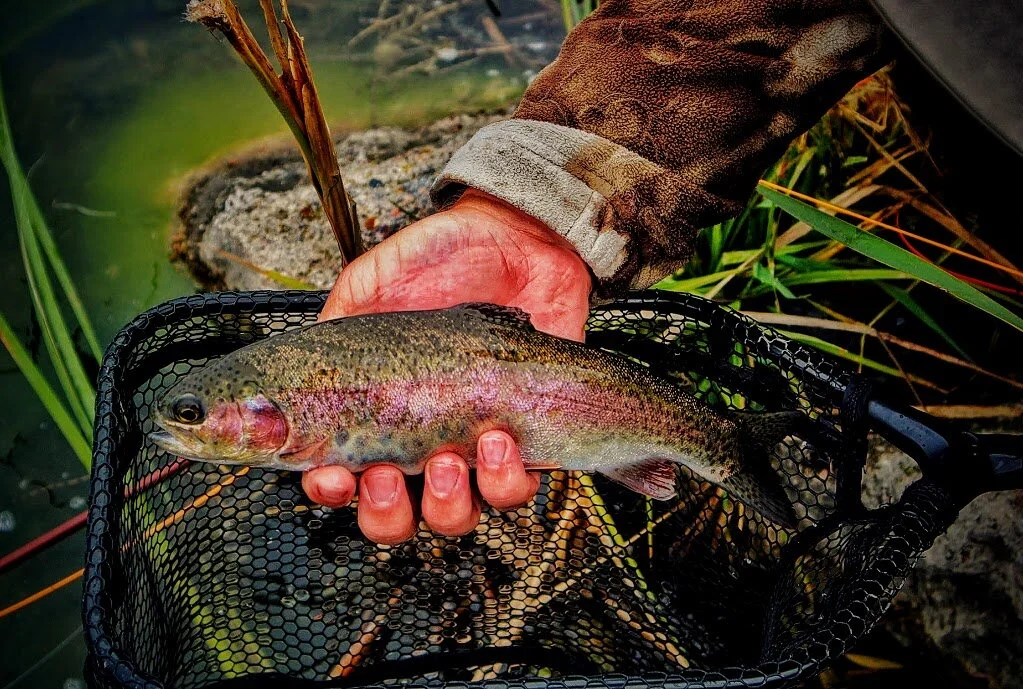Fort Robinson: Testing the Waters
The Thrill of New Water
I consider the true beginning of my outdoors career the first day I ventured out to catch a trout on a fly, nearly three years ago now. When my heart almost exploded with excitement as trout, landscape, and fly rod all seemingly came together, welcoming me into a lifestyle that I know now, I will never give up. While I believe, in some way, all of us are called to the wild, to breathe in God's creative majesty, only a few of us are called to take up a fly rod, journey into that wild, and begin a lifelong obsession of pursuing the illusive fish known as a trout.
While I have carved up a very successful (thus far) career of studying and documenting my adventures here in my local streams of western Nebraska, my heart burns to explore new water. In my down time, I often find myself glued to a screen, watching youtube films of exotic fly fishing adventures in Alaska, or New Zealand. While I know that one day, I will inevitably have to journey to these monumental locations, as I feel I'm called to do once I have earned the right. But, once I discovered streams just miles away from where I live here in Nebraska, I discovered that even just a little further, there was even more fly water to be had. Wyoming is not far, and while it feels a bit overwhelming to consider where one should go, not wanting to just go where everyone else would go, I have found it's a little easier to start out a little smaller. This had led me to narrow my sights on the streams and rivers in the north western chunk of Nebraska, where the land begins to mimic its next door neighbors, Wyoming and South Dakota. Large bluffs, lush pine groves, and the fading of sandstone into boulders and moss covered rock formations welcome you into this shockingly gorgeous portion of Nebraska. While once a long time ago, I had been in the Fort Robinson area, I had no idea that some of the most praised streams and rivers ran right through this state park. In fact, I think it's almost criminal how undersold the fishing is for this area. As you explore just beyond the actual historical buildings and tourism, you enter into a lush western landscape. Towering bluffs, thick groves of aspens and pines, and the faint sound of what I had come here for: the gurgle of a stream.
The White River as it flows through Fort Robinson State Park.
I made my maiden fishing trip here with my friend Andy, him not much of an angler, but a very competent photographer, and a very trusty travel companion. It hardly felt like travel though, as it was barely an hour's drive from where I live. We journeyed here on a day that was cloudy and overcast, with the slightest bit of moisture in the air, giving the ground a slippery shine. We arrived and pulled off down a well maintained forest road, which pulled up to a neat little parking area. I was taken aback by just how clean and well maintained the area was, even though we were miles away from the actual landmark of building and museums that make up Fort Robinson. I was equally shocked by our welcoming crowd, a small herd of Texas longhorns. They wandered freely over the forest road we drove on, and though they were curious, they had no second thought to us. It was quite comical actually. A beast so big and intimidating, but so shy and docile. My goal as I got here was to fish both the White River, and Soldier Creek. Both of these being fisheries I had heard many stories about, holding wild brook trout, rainbow trout, browns, and even some cutthroats. And apparently, in some hidden little ponds tucked away in the bluffs, tiger trout can also be found. I have heard that some anglers have completed trout slams (catching all of the species of trout that the state offers) in one single day, and all caught from these waters.
I’m actually considering moving upstream in this picture, due to this spot now having any riffles or pools that could hold fish.
We started on the White River, me using my RisenFly 9 foot 4wt Genesis fly rod, and using a tiny stonefly pattern nymph that has worked very well for me in these small streams as what I call an "ice breaker fly". A fly I generally throw in new water, when it’s not obvious what the hatch is, or what else they might be feeding on. As Andy and I began moving upstream, I began looking for significant riffles, or pools that could hold a trout or two. It would be pretty difficult going if you didn’t have waders, but I had my Cabelas chest waders, and Andy was wearing a set of shotgun waders I bought some time before, so we were able to move pretty easily between land and water. After just a few minutes of changing positions, making arrogant remarks like, “Oh there’s definitely a fish there” or “I can just see a big bow holding up here”, my efforts were finally rewarded with a nice sized brown trout, who actually had half a creek chub hanging out of its mouth.
A healthy looking brown trout, my first fish caught in The White River.
He gave a great fight, and after he was allowed to rest, I released him back into his pool to chase more creek chub. We decided that since we only had a few hours of daylight left, we should probably get moving to our next spot. After we shot some photos of the area, we hiked back to my car, and headed up into the actual body of the park. We drove passed the historic buildings, towering brick structures, hailing clearly from a distant time, alluring travelers to come and drink in their history. Had we more time to spend, I would have liked to go on a more luxurious tour of the grounds, but Andy and I were on a mission. We drove past them into where the building sites end, and the lush Soldier Creek wilderness begins. The further we drove on that bumpy dirt road, the less modern the area looked, until really the only reminders of a modern world were the odd barbed wire fence. As we headed to where the hiking trails for Soldier Creek began, I remembered that a small lake actually was actually nestled just before the creek, called Carter P Reservoir, so we pulled off at a sign for it. As we arrived and looked around, I was actually pleasantly surprised. Most public lakes I have visited in Nebraska are woefully neglected, and often trashed by their locals. But Carter P was clean, neat, and remote enough I believe to not get too many visitors. Some nicely maintained signs on the little lakeside showed what species of fish swam within its waters, including bass, bluegill, catfish, and rainbow trout. As soon as I saw that, I had to wet a line. Despite a cold wind blowing, the occasional drizzle, I began casting. As I did, I started seeing trout jumping. And I saw some very large ones. Within a few minutes, I switched to a larger streamer, and was rewarded with a fat healthy rainbow trout.
My first Carter P Reservoir rainbow trout.
Eventually after I fished the little lake a bit longer, we returned to my car, to head to our final destination: Soldier Creek. The creek actually splits into two forks, called The Middle Fork, and the South Fork. Both branches of water receive mixed reviews from anglers, which are either true, or just a clever ploy to detour other anglers from fishing their honey holes. A clever method, one I have impishly used myself, in fact, haha. I myself have seen a picture taken within the last year of a brown trout that was at least three pounds, caught out of none other than Soldier Creek. Often times, an angler’s joy and pride in his catch, when caught on camera, can be another angler’s star in the sky, revealing where he himself must go to catch a fish of his own. It pays to pay close attention to social media as far as fish are concerned.
We reached the end of where one can drive a four wheeled vehicle, and began hiking through the trees, up bluffs, and down deep ravines, always staying close to the creek. In the back of my mind, I was hoping we would come across some of the hidden ponds I had heard about. As we hiked, every now and again I was glance at the stream, and see the quick darting shadow of a trout, and sometimes, I’d see a whole school of them. Admittedly, the fishing there is, for the most part, VERY close quarters. You’d almost be more successful to fish with a Tenkara rod rather than a traditional fly rod. And despite fishing some pools that I saw many trout in, and having a few break off, I didn’t actually catch anything. As our goal was to find these hidden ponds, we kept a brisk pace. The light drizzles kept the ground cold and wet, so we both ended up being soaked, and covered in mud. I of course was fixated on fishing, so temporarily, I was impervious to cold. We must have hiked several miles, but unfortunately, we did not find the ponds. We eventually caved in, and began the long hike back to the car. Fort Robinson is one fo the most unique fisheries I’ve ever seen. It boasts amazing fly fishing opportunities, and is one of the only fisheries I’ve ever heard of that offers all four native species of trout, as well as tiger trout, all in one general area. On top of that, the area also host largemouth, and soon, smallmouth bass. Despite being a historical fort, and then later tourist attractive and western culture monument, Fort Robinson is secretly one of the best fisheries in the state. But what supports it being such, is its secrets.
It has taken me a long time to discover even the tiny amount of insight that I have gained on this place, but it’s more than enough to keep me coming back. There are some true legends swimming in those waters, and more secrets, waiting to be explored.
A smaller section of Soldier Creek as it winds its way through the hills in the Soldier Creek Wilderness area, boasting its mid October colors.





